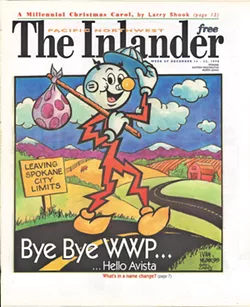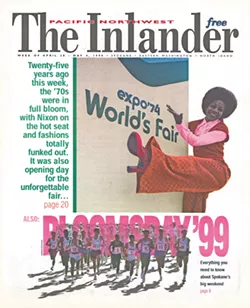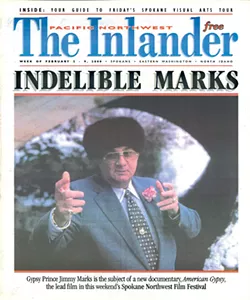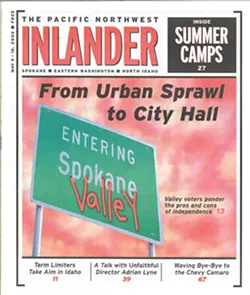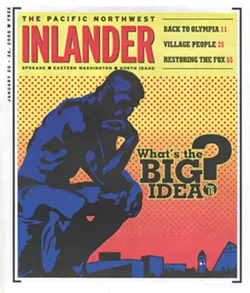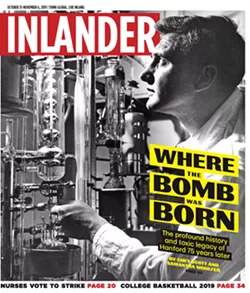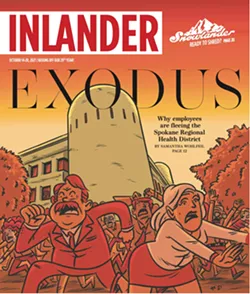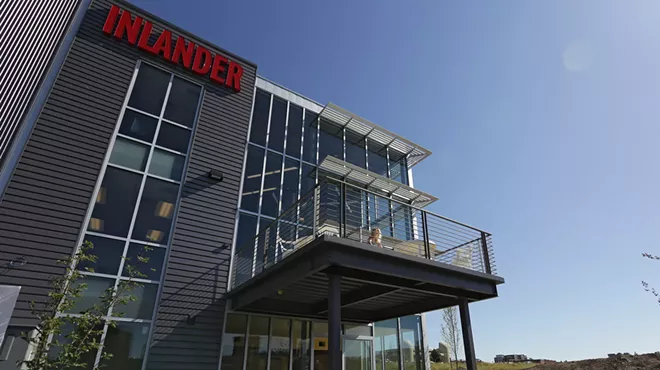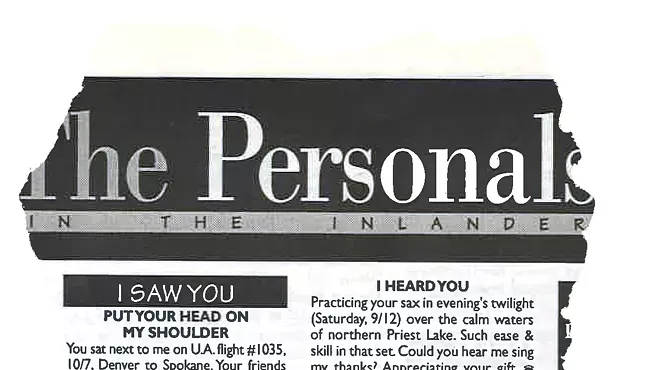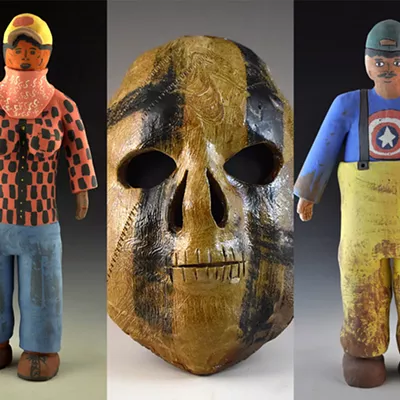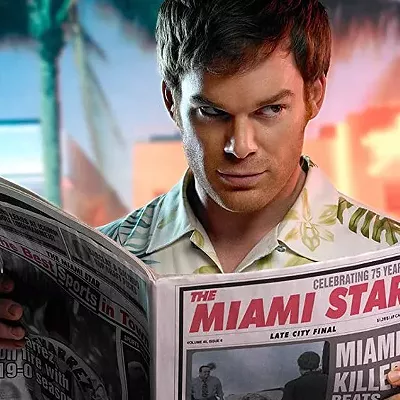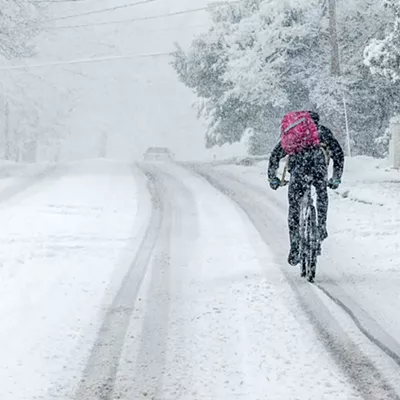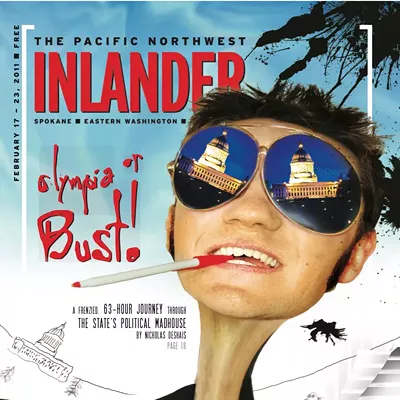1993
There's a lot of talk these days about the state of DOWNTOWN SPOKANE. The visible homelessness. The vacant office space. Well, we've been talking about it for a while. In November 1993, we looked at West First Avenue. "Five years from now, drugs and sex no longer will be sold," we wrote. "If ambitious plans for the district materialize... residents will feel safe again." That's just what happened, at least on this stretch of town. Now it's home to a variety of trendy shops and restaurants, connecting downtown to Browne's Addition.
1994
We called it. In a February 1994 story about the "INFORMATION SUPERHIGHWAY," we predicted that "one day every television will be transformed ... into a personal computer terminal." We could've gone further and said that your phone will be a computer, TV and more. It's just not a phone anymore. It's where you play Wordle. Or Pokémon. Or whatever.
1995
Before we became all-consumed by our phones, let's face it, we were bored. That explains the phenomenon of CRUISIN' RIVERSIDE. In June 1995, we headed downtown for a ridealong with Spokane police on a busy Saturday night. "When you really think about it, cruising seems to be the silliest thing imaginable," wrote Associate Editor Amy Cannata. "But upon further reflection, and after spending some time among the cruisers, you see it's all part of that crazy thing called growing up."
1996
Remember like a month ago when it was nearly 100 degrees, then, a day later, it wasn't? Or that August week when it was super hot, then super windy, then catastrophic fires destroyed parts of Medical Lake and threatened Spokane? Or that fall night in 2019 when wet snow came down while leaves were still on the trees, wreaking havoc across the Inland Northwest? Or windstorm 2015? Well, all of that was yet to come in 1996 when ICE STORM crippled the region with 1.24 inches of freezing rain, coating everything in a thick sheet of ice. Back then, we wrote about it as if it were a once-in-a-generation reminder of nature's fearsome power. Now, we're getting used to the wild weather patterns of global weirding, and wondering what's next.
1997
In February 1997, longtime columnist Robert Herold took aim at plans for a LINCOLN STREET BRIDGE. If you haven't heard of it, that's because Herold had particularly good aim. It was a terrible idea. City leaders and some downtown property owners hatched plans to convert the Monroe Street Bridge into a four-lane span for one-way traffic, and paired it with a new bridge — right over the Spokane Falls — of equally/disastrously wide one-way traffic. Thanks to dogged coverage by Herold, who passed away last year, and lots of lovers of the Falls, the Lincoln Street Bridge was quietly scuttled.
1998
Remember when AVISTA was called Washington Water Power? That was the topic of a big story in December 1998 that explored the growing trend of deregulation in the energy industry. Local WWP investors fretted about losing "Washington" in the name, worrying the new moniker was a harbinger of less local control. They had good reason to worry: The deregulation that led to the Avista name also led to Enron, the Texas-based company that was the darling of financiers before it was revealed that the company, valued at $101 billion, was engaged in accounting fraud. That company's eventual bankruptcy sent shocks through the world economy. In the meantime, Avista is still headquartered in Spokane and sends shocks — I mean electricity — to hundreds of thousands of people in Washington, Idaho and Oregon.
1999
As the century ended and the people of the world fretted about Y2K (look it up, Zoomers), we looked back. In separate issues, we marked the 25th anniversary of EXPO '74, which we'll oh-so-certainly mark again as the Spokane-defining event turns 50 next year. And we celebrated the 10th year of the Inland Northwest-spanning CENTENNIAL TRAIL, which has only grown in length and popularity since. As was once ungrammatically said, Spokane is near nature, near perfect.
2000
If you don't remember the name JIMMY MARKS, a curse be upon Spokane City Hall. In a February 2000 issue, we wrote about Marks, who said more than once that he put a curse on the city. He also sued the city of Spokane, eventually winning a $1.43 million dollar settlement related to a police raid of the Marks' home. The Marks, a Romani family, called the police raid "armed robbery" while the police pointed to evidence from 35 burglaries recovered at the scene. At Jimmy's funeral, his son said the curse had been lifted.
2001
As the Inlander turns 30, an age that no self-respecting hippie can trust, it's a good time to reflect on the troubled state of journalism in which this weekly has endured and thrived. One sign of how bad it's been is the round of lay-offs the SPOKESMAN-REVIEW had in 2001, when its newsroom was reduced by 25 people to 150. Like with every other paper in the nation (thanks, internet!), more layoffs and difficult times were to come over the years. Yet the daily is still pumping out news and remains locally owned. Just like the Inlander. As the Spokesman's management told us in a 2001 story, the paper "will remain one of the country's top papers of its size [which keeps changing]."
2002
Where once was Dishman, Opportunity, Trentwood, Veradale, part of Greenacres, and East Spokane, now there is the CITY OF SPOKANE VALLEY. That was the gist of a May 2002 cover story on Valley residents voting to incorporate as a real deal city. "They look like a city, they act like a city, they just need to draw a line around it and become a city," said Dennis Scott, who ran the campaign for the incorporation effort. Twenty-plus years later, we still wonder: Where's the city's center?
2003
There once was a beautiful Art Deco building called the Rookery Block in downtown Spokane. In 2003, it sat empty. This was just three years after River Park Square opened. The bustling new mall and the spate of old empty buildings was the subject of an April 2003 cover story called "Empty Spaces." The story's first big photo was of the Rookery Block, and its caption wondered if the building would be rehabilitated, replaced by a skyscraper, or turned into "yet another surface-level parking lot." Three years later, we found out the answer. It joined the many PARKING LOTS of downtown Spokane.
2004
When you feel down and think things are just getting worse and worse, remember 2004. When it was worse. The IRAQ WAR was ramping up, and more and more people began to wonder if it was necessary or a good use of our nation's troops and money. The elections — including the one between President GEORGE W. BUSH and JOHN KERRY — were largely run on misinformation and hateful language surrounding GAY MARRIAGE. We covered it all from our little corner of the world.
2005
Nearly 20 years ago, in January 2005, a handful of staffers went searching for ways to THINK BIG. The ideas they gathered were creative and, frankly, way ahead of their time. So I'd like to put them out there once again, in hopes we move forward in this quickly aging 21st century. Merge Spokane and Spokane Valley into one city. Connect the Spokane airport, Coeur d'Alene and points between with light rail. Build more downtown housing. Create a river-centric city and green economy.
2006
In early 2006, a narrative began to unfold in what would become the decade's most gripping local chronicle: the killing of OTTO ZEHM, who died after a violent confrontation with Spokane police officer Karl Thompson. Our first coverage of the troubling event came in October 2006 in a story about Spokane County Prosecuting Attorney Steve Tucker's early decision to not file any charges in Zehm's death. In 2011, a federal jury found Thompson guilty of using excessive force and lying to investigators. Later, former Assistant City Attorney Rocky Treppiedi, a key architect behind the storyline blaming Zehm for his own death, was fired. Then-Assistant U.S. Attorney General Thomas Perez would label the city and police department's handling of the investigation an "extensive cover-up" and a "violent abuse of power."
2007
In February 2007, we took a hard look at the situation for HOMELESS PEOPLE in Spokane County. Even then, we reported that ending homelessness "may never happen," but we found signs of progress, including new funding for homeless programs and a growing economy. Of course, as we know now, the economy tanked (more than once) and homelessness in Spokane is still very present. And growing. In 2007, less than 1,500 people were homeless in Spokane. Now, almost 2,400 people are.
2008
My first cover story for the Inlander ran on Dec. 4, 2008, and it was about how MEDICAL MARIJUANA — legal for 10 years by then — was still treated as an illegal drug, with truly sick and ailing people forced to go to the darkest shadows to procure the only thing that helped with their pain. And the story began with what I still consider one of my most compelling leads, which was about a local man who was nearly killed in a fire as a child, which led to full-body scarring and, later, a brain tumor: "When David Van Scyoc smokes a joint, he cradles it in a hand with no fingers. He takes a hit through remade lips, below a nose that's been rebuilt and on a face created out of destroyed flesh and scar tissue." Van Scyoc died in 2013.
2009
Members of the Spokane, Kalispel, Colville, Coeur d'Alene and Moses-Columbia people have spoken the SALISH LANGUAGE for a very long time. In a May 2009 cover story titled "Saving Salish," staffer Kevin Taylor reported on the fight to preserve the language for future generations. At the time, there were only a handful of elders who could speak the language. Today, that number is growing. Last November, we published another cover story: "es yoyotwílšm nqelixcnm" or "The Salish Resurgence." JR Bluff, director of language for the Kalispel Tribe of Indians, spoke to us for both stories. "Now I have 50, 60, 70 kids that can pray in the language," he said last year.
2010
We reported on a lot in 2010, but the foundation was a nearly staff-wide effort examining the criminal justice system. We ran numerous stories as part of what we deemed the INJUSTICE PROJECT — about the lack of accountability when a cop uses excessive force, the broken juvenile criminal system, how people continue to pay for crimes long after they've served their sentences. But the best was the first, "Reasonable Doubt," by Jacob H. Fries, about three men wrongly imprisoned due to shoddy detective work and lazy prosecution. In 2012, the men were released from prison after their convictions were overturned.
2011
In January 2011 we wrote about a new development in Spokane called KENDALL YARDS, and the trend of people wanting smaller homes. At the time, just 30 units had been sold in Kendall Yards. A "state-of-the-art, energy-efficient 1,100-square-foot house" could be had for less than $160,000. How times have changed. We've seen the "tiny homes" and #VanLife trends come and go, and watched in horror as the median home price went from about $150,000 in 2011 to upwards of $400,000 nowadays. We also watched, more hopefully, as Kendall Yards has continued to grow, including in 2013 when we moved into our own brand-new building overlooking the Spokane River gorge.
2012
In April 2012, we wrote about the catastrophic ICE AGE FLOODS that swept through the Inland Northwest, drastically reshaping the landscape. It was an edition well worth remembering largely because of the illustrations by Jeff Drew accompanying the story. They weren't his first for us — those came with the Scholastic Fantastic issue of 2010 looking at innovative research at local universities. Drew is still in the stable of illustrators we rely on to make the paper look amazing. His most recent work for us included this year's Scholastic Fantastic and, in September 2022, he put a marmot on a bike riding across the Monroe Street Bridge for our story, "Biketown."
2013
In 2008, Washington wildlife managers found evidence of the first breeding WOLF PACK in a quite long time. Five years later we wrote about how, after nearly 50 years on the Endangered Species List, the U.S. Fish & Wildlife Service proposed removing federal protections for gray wolves nationwide, throwing wolf advocates, game managers, ranchers, conservationists and hunters into a pitched battle about the future of the animal. The wolf remains protected in Washington state. In Idaho, they can be killed without a permit if they "molest or attack" livestock or other domestic creatures.
2014
Part of the Inlander's mission is to support the arts and LOCAL MUSIC. That came to sonic fruition in May 2014 with the very first Volume! music festival. For years, we'd had an annual "Bands to Watch" issue, with one-night showcases for those bands and musicians. That grew and transformed into a festival with, as we said then, "80 bands. 5 poets. 1 big party." Sadly, COVID put the festival on ice, but local music continues. For now. As our Music Editor Seth Sommerfeld has written about more than once, but most recently when Lucky You Lounge closed its doors: Support local music or it will cease existing.
2015
Spokane used to have more print newspapers. The Spokane Daily Chronicle and the Local Planet, to name two defunct brethren. Then, in early 2015, a new newspaper showed up. THE BLACK LENS, led by editor and publisher Sandy Williams, published its first monthly edition in January 2015 and focused on all topics pertaining to the Black community. We wrote about it in an article called "A New Voice." Sadly, the publication went on hiatus after it published its January 2022 edition, and Williams, who also founded the Carl Maxey Center, was killed in a plane crash with her partner, Patricia Hicks, later that year.
2016
Mind your p's and q's. In this case, we're wondering why Washington state politicians in 2016 were so focused on TRANSGENDER RIGHTS — a fight that often, and still, finds itself in the bathroom — and we have a lot of Qs. Initiative 1515 aimed to restrict bathroom and locker room access for transgender people. The initiative never made it onto the ballot due to a lack of the necessary signatures. We reported on the issue in June 2016. The story centered on the experience of Jamie Breedlove, a transgender woman who didn't transition until her 60s. "My peace is I'm going to die as Jamie, not Jim," Breedlove said. She died one year later after a battle with cancer.
2017
In September 2017, a nightmare visited the Inland Northwest when a 15-year-old student came to FREEMAN HIGH SCHOOL with a gun and a warning for his friends. By 10 am, Ami Strahan's son, Sam, was dead. We wrote about Ami and her struggle to stay alive that December. "My friends thought I was going to off myself," she told us then. "They were all very worried because I had a really rough few weeks. I just didn't want to live anymore, and they all heard me say that over and over." In 2022, the shooter was sentenced to 40 years in prison.
2018
In 30 years of weekly publishing, we've done it all. Short news briefs and picks for the week's not-to-miss events. Long cover stories that stretch over thousands of words. And, beginning on Sept. 13, 2018, a serialized novel, just like Dickens and Dostoevsky did it. When we published the first installment of MILLER CANE: A TRUE & EXACT HISTORY by local author Samuel Ligon, he didn't quite know where it was headed. By the end of 2019, when the story concluded, our readers knew well the episodic tale of a fraudulent historian who made his living as a conman with a heart.
2019
Before Barbenheimer was Inlander. In October 2019, Chey Scott and Samantha Wohlfeil dove deep into HANFORD, where the nuclear bomb was born. We called Hanford a "place of profound contrast" and looked at both the environmental toll and cultural impact the site has had on the surrounding Tri-Cities area. But while this summer a lot of us became acquainted with the man behind the bomb, J. Robert Oppenheimer, his name was only used once in our Hanford coverage. It came when we wrote about Atomic Ale Brewpub & Eatery in Richland, which had many beers on tap at the time, including Oppenheimer Oatmeal Stout. Sadly, this beer is no longer available and Oppenheimer, turns out, wasn't a communist.
2020
We were on a roll at the beginning of the year, with two big cover stories looking at the population boom and extreme politics of North Idaho. Then, COVID. Yet we persisted. And on March 26 we wrote "A Quiet Place" about the suddenly changed world. It was our first issue after lockdown. We worked from home for more than a year. And we didn't miss a single weekly issue of the Inlander.
2021
We kept reporting and publishing throughout the pandemic and covered a lot of stuff, but our biggest stories remained focused on COVID. In October we published "Exodus," a cover story about how employees of the SPOKANE REGIONAL HEALTH DISTRICT were fleeing in droves. It wasn't just the stress of a global public health crisis or the related upheavals in politics. Instead, workers described a "culture of fear" and a gaping chasm between the administration and staff.
2022
We ended 2022 with a number of stories showing how times have changed in the Inland Northwest. We profiled apartments and made a case for building more of them around town. We described the ways in which Spokane could become a city of bikes. We wrote about the resurgence in Salish speakers in the region. But one of the biggest changes, at least politically, was the retirement of SHERIFF OZZIE KNEZOVICH, who hung up his Stetson after 16 years on the job and headed to Wyoming (where he continues to track and comment on local politics).
2023
And we keep going. This year we've covered sponsorships for student athletes, the little-known seed bank in the Palouse, how local politicians get trolled, the giant condors that once populated our skies, and why our roads are becoming more dangerous. We used stats to compare the Inland Northwest to nine other metros, and we made our own beer. We wrote about the heartbreaking search of a father looking for his homeless son, and went behind the scenes of Spokane's own indie pro wrestling circuit. We looked into the bustling book arts community, and the blooming ranks of professional sourdough bread bakers. But the most impactful of all this year's work was our close look at SECOND AND DIVISION, Spokane's most notorious intersection, where fentanyl, homelessness and the law meet with sometimes disastrous consequences. And we'll keep writing more. ♦
Nicholas Deshais was a staff writer and news editor for the Inlander from 2008-12; he's been the editor of the Inlander since September 2022.


